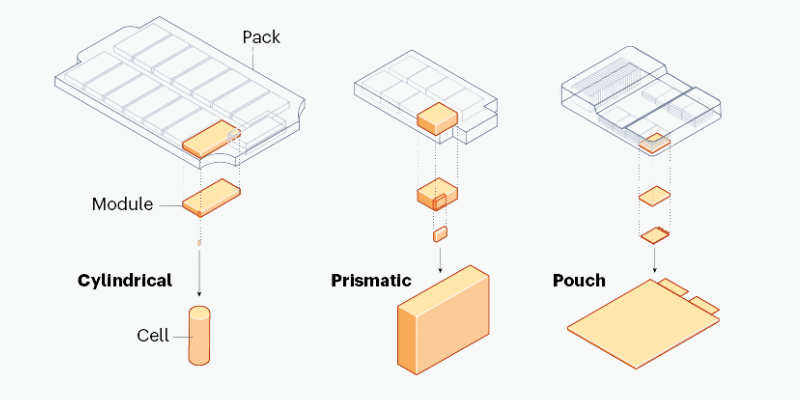Zrozumienie rozróżnienia między ogniwami akumulatorów, modułów i opakowań ma kluczowe znaczenie dla projektowania wydajnych systemów magazynowania energii. W tym artykule bada ich budowę, cechy wydajności i zastosowania.
Ogniwo baterii
Co to jest ogniwo baterii?
Górka akumulatora jest podstawową jednostką baterii, służącej jako mały pojemnik, który przechowuje i uwalnia energię elektryczną poprzez reakcje chemiczne. Składa się z elektrod (anoda i katoda) oddzielone przez elektrolit i zamknięty w obudowie. Można połączyć wiele ogniw, aby utworzyć większą baterię o wyższym napięciu lub pojemności.
Projektowanie ogniw akumulatorów
Rozmiar
Komórki akumulatorów wahają się od małych elektroniki do dużych ogniw w pojazdach elektrycznych, wpływając na pojemność i gęstość energii dla określonych aplikacji.
Kształt
Wchodzą ogniwa akumulatorowe Cylindryczny, pryzmatycznyi projekty torebek.
Komórki cylindryczne:
- Zalety: solidna, spójna wydajność, wysoka gęstość energii.
- Wady: niższa gęstość energii specyficznej niż niektóre formaty.
- Aplikacje: laptopy, elektronarzędzia, przenośna elektronika użytkowa
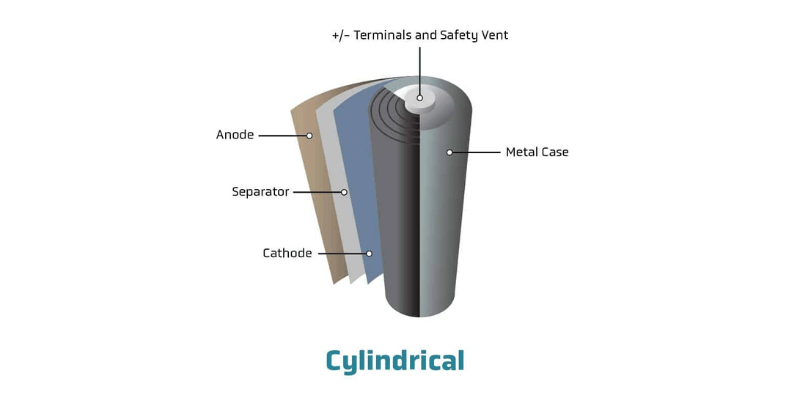
Komórki torebki:
- Zalety: Wysoka gęstość energii, elastyczna konstrukcja, opłacalna.
- Wady: ryzyko obrzęku wymaga starannego zarządzania termicznego.
- Aplikacje: smartfony, tablety
Komórki pryzmatyczne:
- Zalety: Wysoka gęstość energii, wydajne zarządzanie termicznie, skalowalny projekt.
- Wady: mniejsza elastyczność niż komórki torebek.
- Zastosowania: pojazdy elektryczne, systemy magazynowania energii, zastosowania przemysłowe.
Chemia wewnętrzna
Wewnętrzna chemia komórki akumulatorowej określa jego wydajność, w tym napięcie, pojemność i Życie rowerowe. Różne chemię, takie jak litowo-jon, wodorek niklu-metal i ołów, oferują różne kompromisy w gęstości energii, kosztach i bezpieczeństwie. Na przykład litowo-jon jest preferowany ze względu na wysoką gęstość energii w urządzeniach przenośnych.
Materiały elektrody
Materiały elektrody znacznie wpływają na wydajność i długowieczność ogniwa akumulatora. Typowe opcje obejmują tlenek kobaltu litowego (LICOO2), fosforan żelaza litowego (LifePo4) i nikiel manganu (NMC). Każdy oferuje wyraźne profile gęstości energii, stabilności i bezpieczeństwa dostosowane do określonych potrzeb.
Opakowanie i enkapsulacja
Komórki akumulatorów znajdują się w pakowaniu ochronnym, aby zapobiec uszkodzeniom czynników środowiskowych. Opakowanie musi zapewnić izolację, aby uniknąć wycieku elektrolitu, zapewniając jednocześnie długoterminową niezawodność; Właściwe enkapsulacja dotyczy również ryzyka takiego jak ucieczka termiczna lub zwarcia.
Typowe materiały opakowaniowe obejmują:
- Metalowe puszki: chronią one cylindryczne komórki i zapobiegają zwarciom.
- Torebki aluminiowe: oferują elastyczną, lekką obudowę komórek torebek.
- Metalowe obudowy: Te zabezpieczają komórki pryzmatyczne i pomagają w zarządzaniu termicznym.
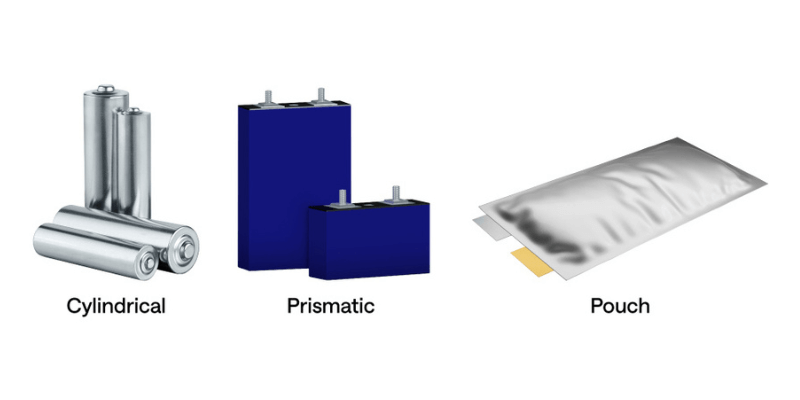
Moduł baterii
Co to jest moduł baterii?
Moduł akumulatora składa się z podłączonych ogniw akumulatorowych umieszczonych w jednej obudowie. Zwiększa napięcie i pojemność układu akumulatora, służąc jako związek między poszczególnymi ogniwami a całym pakietem baterii.
Projekt modułu baterii
Rozmiar i kształt
Rozmiar i kształt modułu akumulatora różnią się w zależności od zastosowania i pożądanego wyjścia energii. Wspólne konfiguracje obejmują:
- Moduły typu torebek: elastyczne i lekkie, stosowane w elektronice użytkowej i pojazdach elektrycznych.
- Moduły pryzmatyczne: sztywne i możliwe do układania, powszechnie występujące w pojazdy elektryczne i systemy magazynowania energii.
- Moduły cylindryczne: wykonane z cylindrycznych komórek, oferujące wysoką gęstość energii i wytrzymałość mechaniczną.
Wewnętrzne materiały chemii i elektrody
Chemia i materiały ogniw akumulatorowych wpływają na ogólną wydajność. Kluczowe czynniki obejmują:
- Materiały anodowe: Wspólnymi opcjami są grafit, krzem i tlenek litu (LTO), każdy oferuje unikalne zalety.
- Materiały katodowe: tlenek kobaltu litu (LCO), tlenek litu manganu (LMO), fosforan żelaza litowego (LFP) i tlenek niklu-kobalt-aluminium (NCA) różnią się gęstością energii, gęstością mocy i żywotnością cyklu.
- Elektrolit: Zazwyczaj ciecz lub ciało stałe, które ułatwia ruch jonowy między anodą a katodą.
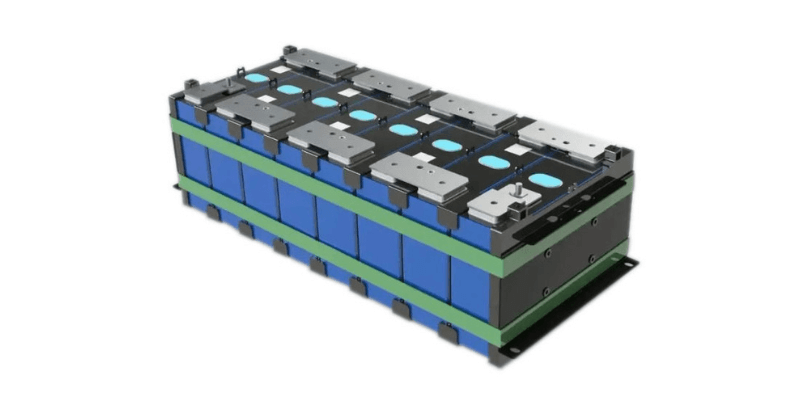
Opakowanie i enkapsulacja
Opakowanie modułu chroni wewnętrzne komponenty, jednocześnie zapewniając bezpieczeństwo. Kluczowe rozważania obejmują:
- Obudowa modułu: Powinien być silny, odporny chemicznie i przewodzący termicznie.
- Połączenie komórek: niezawodne techniki okablowania są niezbędne do połączeń komórek.
- Zarządzanie termicznie: Zapobiega przegrzaniu przy użyciu radiatorów lub materiałów zmiany faz.
- Cechy bezpieczeństwa: Włącz bezpieczniki, wyłączniki lub zawory złagnięcia ciśnienia w celu ograniczenia ryzyka.
System zarządzania baterią (BMS)
BMS jest koniecznością do monitorowania parametrów, takich jak:
- Napięcie komórek: Zapewnia nawet ładowanie i rozładowywanie komórek.
- Temperatura komórek: Zapobiega przegrzaniu lub nadmiernemu chłodzeniu.
- Stan ładunku (SOC): śledzi pozostałą pojemność.
- Stan zdrowia (SOH): szacuje żywotność baterii.
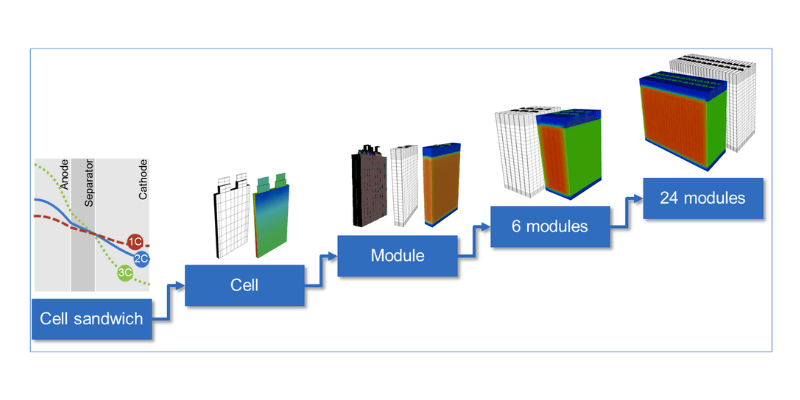
Pakiet akumulatora
Co to jest pakiet baterii?
Pakiet akumulatorowy składa się z ogniw akumulatorowych lub modułów podłączonych do tworzenia pojedynczego źródła zasilania. Komórki są ułożone w szeregu i równolegle Aby osiągnąć pożądane napięcie i prąd. Pakiety akumulatorowe mogą zawierać jedno ogniwo lub tysiące.
Projekt pakietu baterii
Układ ogniw akumulatorów:
- Określ wymagane napięcie i pojemność.
- Wybierz typ i rozmiar ogniwa akumulatora (np. Lit-jon, lit-polimer) w oparciu o potrzeby wydajności.
- Zdecyduj się na konfiguracje szeregowe i równoległe, aby osiągnąć pożądane napięcie i pojemność.
- Zapewnij jednorodność specyfikacji komórek w celu utrzymania równowagi.
Projekt obudowy:
- Wybierz materiały do pakietu akumulatora, które zapewniają siłę, trwałość i skuteczne zarządzanie termicznie.
- Zaprojektuj obudowę, aby skutecznie pomieścić ogniwo baterii. Obejmują otwory wentylacyjne, ciepła lub izolację do regulacji temperatury.
- Chroń komórki przed uszkodzeniem fizycznym i czynnikami środowiskowymi, takimi jak wilgoć i kurz.
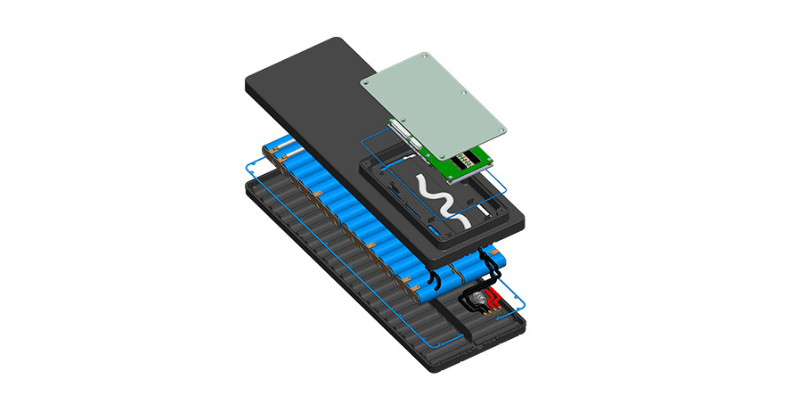
Funkcje bezpieczeństwa:
- Zintegruj BMS do monitorowania ładowania, rozładowywania i temperatury.
- Uwzględnij ochronę nadmiernego ładowania, nadmiernego obciążenia, zwarć i uciekinierów termicznych.
- Zainstaluj bezpieczniki lub wyłączniki do izolacji awaryjnej.
- Zapewnij zgodność z przepisami ONZ/DOT i certyfikatami UL.
Połączenia elektryczne:
- Projektuj o niskiej oporności połączenia elektryczne między ogniwami/modułami/terminale Aby zminimalizować utratę energii.
- Użyj wysokiej jakości materiałów do niezawodnych połączeń, które zmniejszają krople napięcia lub usterki.
- Wdrożyć izolację i ekranowanie, aby zapobiec zakłóceniu łukowym, korozji i elektromagnetycznym.
Testowanie i walidacja:
- Przeprowadź dokładne testowanie wydajności projektowej w różnych warunkach.
- Wykonaj testy warunków skrajnych, takie jak cykl temperatury, testy wibracji; Oceń trwałość.
- Sprawdź zgodność ze standardami branżowymi poprzez rygorystyczne protokoły testowania.
Aplikacje pakietów baterii
- Przenośna elektronika: pakiety akumulatorów zasilające urządzenia mobilne, takie jak smartfony, tablety i laptopy, oferujące wygodne rozwiązania na wynos.
- Pojazdy elektryczne: Pakiety akumulatorowe są pierwotnym magazynem energii w EVS, zapewniając energię napędową do transportu wolnego od emisji.
- Stacjonarne magazynowanie energii: pakiety akumulatorów przechowują nadmiar energii ze źródeł odnawialnych, takich jak słone i wiatr, zasilanie zapasowe, stabilizacja siatki i przesuwanie obciążenia.
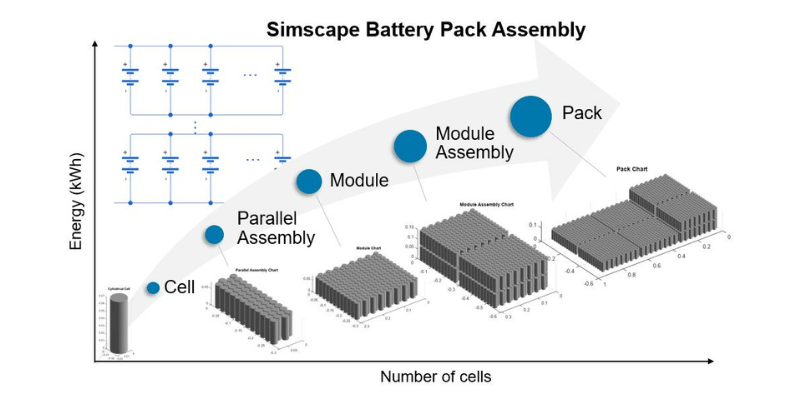
Jaka jest różnica między ogniwem akumulatorowym, modułem akumulatora a pakietem akumulatora?
Aby zrozumieć różnice między ogniwami, modułami i paczkami, rozbijmy każdy komponent:
- Ogniwo akumulatora: podstawowa jednostka magazynowania energii, która przekształca energię chemiczną w energię elektryczną. Występuje w różnych kształtach (cylindryczny, pryzmatyczny lub woreczek) i zawiera anodę, katodę, separator i elektrolit.
- Moduł akumulatora: grupa połączonych ogniw akumulatorowych, które zwiększają napięcie i pojemność w porównaniu do poszczególnych ogniw. Obejmuje okablowanie i złącza oraz może zawierać podstawowy system zarządzania akumulatorami (BMS) do monitorowania.
- Pakiet akumulatora: kompletny system magazynowania energii zawierający jeden lub więcej modułów. Obejmuje zaawansowane BMS do równoważenia komórek, kontroli temperatury i funkcji bezpieczeństwa, a także dodatkowe komponenty, takie jak systemy obudowy i zarządzania termicznie.
Streszczenie:
- Ogniwo akumulatora: najmniejsza jednostka.
- Moduł akumulatora: grupa podłączonych ogniw.
- Pakiet akumulatora: kompletny system z modułami i BMS.
Analogia:
- Ogniwo akumulatora: pojedyncza cegła.
- Moduł baterii: ściana wykonana z kilku cegieł.
- Pakiet akumulatora: budynek wykonany z wielu ścian.

